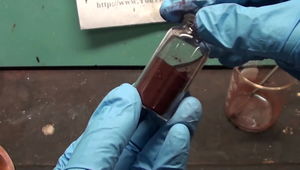Potassium rhodizonate
 Freshly prepared potassium rhodizonate
| |
| Names | |
|---|---|
| IUPAC name
Dipotassium 3,4,5,6-tetraoxocyclohexene-1,2-diolate
| |
| Other names
5-Cyclohexene-1,2,3,4-tetrone, 5,6-dihydroxy-, dipotassium salt
Dipotassium rhodizonate Rhodizonic acid dipotassium salt | |
| Properties | |
| C6O6K2 | |
| Molar mass | 246.257 g/mol |
| Appearance | Black-reddish solid |
| Melting point | >300 °C (572 °F; 573 K) (decomposition) |
| Boiling point | Decomposes |
| Almost insoluble | |
| Solubility | Slightly soluble in glacial acetic acid Insoluble in isopropanol |
| Hazards | |
| Safety data sheet | Sigma-Aldrich |
| Flash point | Non-flammable |
| Related compounds | |
| Related compounds
|
Rhodizonic acid |
| Except where otherwise noted, data are given for materials in their standard state (at 25 °C [77 °F], 100 kPa). | |
| Infobox references | |
Potassium rhodizonate is a chemical compound, the potassium salt of rhodizonic acid.
Contents
[hide]Properties
Chemical
Potassium rhodizonate reacts with lead and lead compounds to give the dark purple lead rhodizonate.
Potassium rhodizonate breaks down under alkaline conditions and is only stable at low pH.
Physical
Potassium rhodizonate is a black-reddish solid, poorly soluble in water and organic solvents.
Availability
Potassium rhodizonate is sold by many suppliers.
Preparation
Potassium rhodizonate can be prepared by oxidizing inositol with conc. nitric acid.
In a beaker or round bottom flask add 10 g of inositol and 25 ml of nitric acid 68%. The mixture is refluxed for 3 hours. As this happens, the solution will give off nitrogen dioxide fumes, so make sure you do this outside or in a fume hood. After the reaction has stopped, add water until the volume reaches 100 ml. Then add 50 ml of glacial acetic acid, which will keep the solution acidic, as rhodizonates are unstable in basic conditions. Place the beaker in an ice bath. Slowly then add 40 g of potassium hydroxide. The addition of KOH will cause the solution to heat up and bubble, as well as change color from colorless to black/black-red, which is the potassium rhodizonate precipitating out of the solution. To increase the yield, leave the potassium rhodizonate solution to stir overnight, as dissolved oxygen will oxidize other intermediate reaction products into rhodizonate. The next day, filter the solution through a filter paper and wash the precipitate with 100 ml of isopropanol and then leave the potassium rhodizonate to dry in air.[1]
NurdRage made a video on how to synthesize it.[2]
Projects
- Testing for lead
Handling
Safety
Potassium rhodizonate is not classified as hazardous and doesn't require special handling.
Storage
In closed bottles, away from light and bases. Solutions are only stable for about 1 hour so they must be used immediately.
Disposal
Potassium rhodizonate doesn't require special disposal. Discard it as you wish.
References
- Jump up ↑ J. Am. Chem. Soc., 1942, 64 (1), p. 67–69
- Jump up ↑ https://www.youtube.com/watch?v=BLmycZ2nrt0